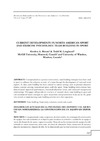Please use this identifier to cite or link to this item:
https://accedacris.ulpgc.es/jspui/handle/10553/7849
| DC Field | Value | Language |
|---|---|---|
| dc.contributor.author | Bloom, Gordon A. | en_US |
| dc.contributor.author | Loughead, Todd M. | en_US |
| dc.date.accessioned | 2012-08-11T04:01:01Z | - |
| dc.date.accessioned | 2018-03-08T13:20:07Z | - |
| dc.date.available | 2012-08-11T04:01:01Z | - |
| dc.date.available | 2018-03-08T13:20:07Z | - |
| dc.date.issued | 2011 | en_US |
| dc.identifier.issn | 1886-8576 | en_US |
| dc.identifier.uri | https://accedacris.ulpgc.es/handle/10553/7849 | - |
| dc.description.abstract | Conceptualized as a process intervention, team building strategies have been used in sport to enhance the cohesion or unity of a team through the development of task and social aspects. To date, team building has been utilized in various settings such as physical education classes, exercise settings, recreational sport, and elite sport. Team building interventions have demonstrated improved performance, increased adherence levels, and enhanced interpersonal relationships. This paper will provide an overview of research about team building in sport and will recommend future strategies to sport researchers and practitioners from across the globe who intend on implementing team building activities into their repertoire. | en_US |
| dc.format | application/pdf | es |
| dc.language | eng | en_US |
| dc.relation.ispartof | Revista Iberoamericana de Psicologia del Ejercicio y el Deporte | en_US |
| dc.source | Revista Iberoamericana de Psicología del Ejercicio y el Deporte. Sevilla : Wanceulen, 2006 [ISSN 1886-8576], 2011, v. 6 (2) p. 237-249 | en_US |
| dc.subject | 61 Psicología | en_US |
| dc.subject.other | Team building | en_US |
| dc.subject.other | Team unity | en_US |
| dc.subject.other | Cohesion | en_US |
| dc.subject.other | Social | en_US |
| dc.subject.other | Task | en_US |
| dc.subject.other | Coach | en_US |
| dc.title | Current developments in North American sport and exercise psychology: team building in sport | en_US |
| dc.type | info:eu-repo/semantics/article | en_US |
| dc.type | Article | en_US |
| dc.compliance.driver | 1 | es |
| dc.identifier.absysnet | 537108 | es |
| dc.identifier.crisid | -;- | - |
| dc.investigacion | Artes y Humanidades | en_US |
| dc.rights.accessrights | info:eu-repo/semantics/openAccess | es |
| dc.type2 | Artículo | en_US |
| dc.identifier.ulpgc | Sí | es |
| dc.description.sellofecyt | Sello FECYT | |
| dc.description.esci | ESCI | |
| dc.description.erihplus | ERIH PLUS | |
| item.fulltext | Con texto completo | - |
| item.grantfulltext | open | - |
| Appears in Collections: | Rev. Iberoam. psicol. ejerc. deporte. 2011. v.6, n.2 Artículos | |
Page view(s)
365
checked on Mar 1, 2025
Download(s)
396
checked on Mar 1, 2025
Google ScholarTM
Check
Share
Export metadata
Items in accedaCRIS are protected by copyright, with all rights reserved, unless otherwise indicated.
